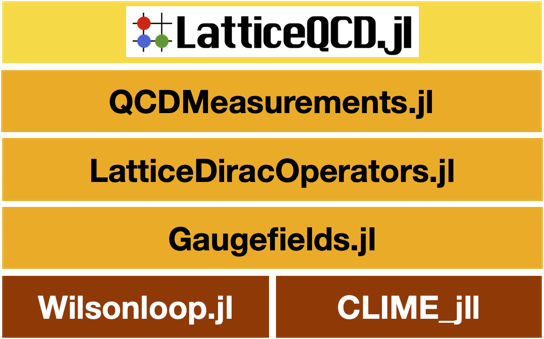In Lattice Quantum Chromo-Dynamics (QCD), the gauge action is constructed by gauge invariant objects, Wilson loops, in discretized spacetime. Wilsonloop.jl helps us to treat with the Wilson loops and generic Wilson lines in any Nc and dimensions.
This is a package for lattice QCD codes.
This package is used in LatticeQCD.jl and a code in a project JuliaQCD.
- From a symbolic definition of Wilson lines, this returns SU(Nc)-valued Wilson lines as objects
- Constructing all staples from given symbolic Wilson lines
- Constructing derivatives of given symbolic Wilson lines (auto-grad for SU(Nc) variables)
add WilsonloopIn Julia, adjoint represents hermitian conjugate, and we follow this terminology.
For example Adjoint_GLink means hermitian conjugate of a gauge link, not the link in the adjoint representation.
Please do not confuse with a link in the adjoint representation in conventional lattice QCD context. We do not support links in adjoint representation.
This package defines Wilsonline{Dim} type.
mutable struct Wilsonline{Dim}
glinks::Array{GLink{Dim},1}
endThis is a array of GLink{Dim}.
The GLink{Dim} is defined as
abstract type Gaugelink{Dim} end
struct GLink{Dim} <: Gaugelink{Dim}
direction::Int8
position::NTuple{Dim,Int64}
isdag::Bool
end
GLink{Dim} has a direction of a bond on the lattice and relative position get_direction(a) and get_position(a), respectively.
For example if we want to have 2nd link of the Wilson loop w, just do get_position(w[2]).
We can easily generate a plaquette.
println("plaq")
plaq = make_plaq()
display(plaq)The output is
plaq
1-st loop
L"$U_{1}(n)U_{2}(n+e_{1})U^{\dagger}_{1}(n+e_{2})U^{\dagger}_{2}(n)$"
2-nd loop
L"$U_{1}(n)U_{3}(n+e_{1})U^{\dagger}_{1}(n+e_{3})U^{\dagger}_{3}(n)$"
3-rd loop
L"$U_{1}(n)U_{4}(n+e_{1})U^{\dagger}_{1}(n+e_{4})U^{\dagger}_{4}(n)$"
4-th loop
L"$U_{2}(n)U_{3}(n+e_{2})U^{\dagger}_{2}(n+e_{3})U^{\dagger}_{3}(n)$"
5-th loop
L"$U_{2}(n)U_{4}(n+e_{2})U^{\dagger}_{2}(n+e_{4})U^{\dagger}_{4}(n)$"
6-th loop
L"$U_{3}(n)U_{4}(n+e_{3})U^{\dagger}_{3}(n+e_{4})U^{\dagger}_{4}(n)$"
If we want to consider 2D system, we can do make_plaq(Dim=2).
The staple of the plaquette is given as
for μ=1:4
println("μ = $μ")
staples = make_plaq_staple(μ)
display(staples)
endThe output is
μ = 1
1-st loop
L"$U_{2}(n+e_{1})U^{\dagger}_{1}(n+e_{2})U^{\dagger}_{2}(n)$"
2-nd loop
L"$U^{\dagger}_{2}(n+e_{1}-e_{2})U^{\dagger}_{1}(n-e_{2})U_{2}(n-e_{2})$"
3-rd loop
L"$U_{3}(n+e_{1})U^{\dagger}_{1}(n+e_{3})U^{\dagger}_{3}(n)$"
4-th loop
L"$U^{\dagger}_{3}(n+e_{1}-e_{3})U^{\dagger}_{1}(n-e_{3})U_{3}(n-e_{3})$"
5-th loop
L"$U_{4}(n+e_{1})U^{\dagger}_{1}(n+e_{4})U^{\dagger}_{4}(n)$"
6-th loop
L"$U^{\dagger}_{4}(n+e_{1}-e_{4})U^{\dagger}_{1}(n-e_{4})U_{4}(n-e_{4})$"
μ = 2
1-st loop
L"$U^{\dagger}_{1}(n-e_{1}+e_{2})U^{\dagger}_{2}(n-e_{1})U_{1}(n-e_{1})$"
2-nd loop
L"$U_{1}(n+e_{2})U^{\dagger}_{2}(n+e_{1})U^{\dagger}_{1}(n)$"
3-rd loop
L"$U_{3}(n+e_{2})U^{\dagger}_{2}(n+e_{3})U^{\dagger}_{3}(n)$"
4-th loop
L"$U^{\dagger}_{3}(n+e_{2}-e_{3})U^{\dagger}_{2}(n-e_{3})U_{3}(n-e_{3})$"
5-th loop
L"$U_{4}(n+e_{2})U^{\dagger}_{2}(n+e_{4})U^{\dagger}_{4}(n)$"
6-th loop
L"$U^{\dagger}_{4}(n+e_{2}-e_{4})U^{\dagger}_{2}(n-e_{4})U_{4}(n-e_{4})$"
μ = 3
1-st loop
L"$U^{\dagger}_{1}(n-e_{1}+e_{3})U^{\dagger}_{3}(n-e_{1})U_{1}(n-e_{1})$"
2-nd loop
L"$U_{1}(n+e_{3})U^{\dagger}_{3}(n+e_{1})U^{\dagger}_{1}(n)$"
3-rd loop
L"$U^{\dagger}_{2}(n-e_{2}+e_{3})U^{\dagger}_{3}(n-e_{2})U_{2}(n-e_{2})$"
4-th loop
L"$U_{2}(n+e_{3})U^{\dagger}_{3}(n+e_{2})U^{\dagger}_{2}(n)$"
5-th loop
L"$U_{4}(n+e_{3})U^{\dagger}_{3}(n+e_{4})U^{\dagger}_{4}(n)$"
6-th loop
L"$U^{\dagger}_{4}(n+e_{3}-e_{4})U^{\dagger}_{3}(n-e_{4})U_{4}(n-e_{4})$"
μ = 4
1-st loop
L"$U^{\dagger}_{1}(n-e_{1}+e_{4})U^{\dagger}_{4}(n-e_{1})U_{1}(n-e_{1})$"
2-nd loop
L"$U_{1}(n+e_{4})U^{\dagger}_{4}(n+e_{1})U^{\dagger}_{1}(n)$"
3-rd loop
L"$U^{\dagger}_{2}(n-e_{2}+e_{4})U^{\dagger}_{4}(n-e_{2})U_{2}(n-e_{2})$"
4-th loop
L"$U_{2}(n+e_{4})U^{\dagger}_{4}(n+e_{2})U^{\dagger}_{2}(n)$"
5-th loop
L"$U^{\dagger}_{3}(n-e_{3}+e_{4})U^{\dagger}_{4}(n-e_{3})U_{3}(n-e_{3})$"
6-th loop
L"$U_{3}(n+e_{4})U^{\dagger}_{4}(n+e_{3})U^{\dagger}_{3}(n)$"
1-st loop
L"$U^{\dagger}_{1}(n-e_{1})U_{4}(n-e_{1})U_{1}(n-e_{1}+e_{4})$"
2-nd loop
L"$U_{1}(n)U_{4}(n+e_{1})U^{\dagger}_{1}(n+e_{4})$"
3-rd loop
L"$U^{\dagger}_{2}(n-e_{2})U_{4}(n-e_{2})U_{2}(n-e_{2}+e_{4})$"
4-th loop
L"$U_{2}(n)U_{4}(n+e_{2})U^{\dagger}_{2}(n+e_{4})$"
5-th loop
L"$U^{\dagger}_{3}(n-e_{3})U_{4}(n-e_{3})U_{3}(n-e_{3}+e_{4})$"
6-th loop
L"$U_{3}(n)U_{4}(n+e_{3})U^{\dagger}_{3}(n+e_{4})$"
The arbitrary Wilson loop is constructed as
loop = [(1,+1),(2,+1),(1,-1),(2,-1)]
println(loop)
w = Wilsonline(loop)
println("P: ")
show(w)Its adjoint is calculated as
println("P^+: ")
show(w')Its staple is calculated as
println("staple")
for μ=1:4
println("μ = $μ")
V1 = make_staple(w,μ)
V2 = make_staple(w',μ)
show(V1)
show(V2)
endThe derivative of the lines
println("derive w")
for μ=1:4
dU = derive_U(w,μ)
for i=1:length(dU)
show(dU[i])
end
endNote that the derivative is a rank-4 tensor.
The output is
L"$I \otimes U_{2}(n+e_{1})U^{\dagger}_{1}(n+e_{2})U^{\dagger}_{2}(n)\delta_{m,n}$"
L"$U_{1}(n-e_{1}) \otimes U^{\dagger}_{1}(n-e_{1}+e_{2})U^{\dagger}_{2}(n-e_{1})\delta_{m,n+e_{1}}$"
The derivatives are usually used for making the smearing of the gauge fields (Stout smearing can be used in Gaugefields.jl).
mu = 1
nu = 2
rho = 3
loops = [(mu,2),(nu,1),(rho,3),(mu,-2),(rho,-3),(nu,-1)]
w = Wilsonline(loops)L"$U_{1}(n)U_{1}(n+e_{1})U_{2}(n+2e_{1})U_{3}(n+2e_{1}+e_{2})U_{3}(n+2e_{1}+e_{2}+e_{3})U_{3}(n+2e_{1}+e_{2}+2e_{3})U^{\dagger}_{1}(n+e_{1}+e_{2}+3e_{3})U^{\dagger}_{1}(n+e_{2}+3e_{3})U^{\dagger}_{3}(n+e_{2}+2e_{3})U^{\dagger}_{3}(n+e_{2}+e_{3})U^{\dagger}_{3}(n+e_{2})U^{\dagger}_{2}(n)$"
Its staple:
staple = make_staple(w,mu)1-st loop
L"$U_{1}(n+e_{1})U_{2}(n+2e_{1})U_{3}(n+2e_{1}+e_{2})U_{3}(n+2e_{1}+e_{2}+e_{3})U_{3}(n+2e_{1}+e_{2}+2e_{3})U^{\dagger}_{1}(n+e_{1}+e_{2}+3e_{3})U^{\dagger}_{1}(n+e_{2}+3e_{3})U^{\dagger}_{3}(n+e_{2}+2e_{3})U^{\dagger}_{3}(n+e_{2}+e_{3})U^{\dagger}_{3}(n+e_{2})U^{\dagger}_{2}(n)$"
2-nd loop
L"$U_{2}(n+e_{1})U_{3}(n+e_{1}+e_{2})U_{3}(n+e_{1}+e_{2}+e_{3})U_{3}(n+e_{1}+e_{2}+2e_{3})U^{\dagger}_{1}(n+e_{2}+3e_{3})U^{\dagger}_{1}(n-e_{1}+e_{2}+3e_{3})U^{\dagger}_{3}(n-e_{1}+e_{2}+2e_{3})U^{\dagger}_{3}(n-e_{1}+e_{2}+e_{3})U^{\dagger}_{3}(n-e_{1}+e_{2})U^{\dagger}_{2}(n-e_{1})U_{1}(n-e_{1})$"
The derivative of the staple
dev = derive_U(staple[1],nu)L"$U_{1}(n-e_{1}) \otimes U_{3}(n+e_{2})U_{3}(n+e_{2}+e_{3})U_{3}(n+e_{2}+2e_{3})U^{\dagger}_{1}(n-e_{1}+e_{2}+3e_{3})U^{\dagger}_{1}(n-2e_{1}+e_{2}+3e_{3})U^{\dagger}_{3}(n-2e_{1}+e_{2}+2e_{3})U^{\dagger}_{3}(n-2e_{1}+e_{2}+e_{3})U^{\dagger}_{3}(n-2e_{1}+e_{2})U^{\dagger}_{2}(n-2e_{1})\delta_{m,n+2e_{1}}$"
The derivative of the Wilson loops with respect to a link is a rank-4 tensor (ref), which is expressed as
, where A and B are matrices.
We can get the A and B matrices, expressed by Wilsonline{Dim} type :
devl = get_leftlinks(dev[1])
devr = get_rightlinks(dev[1])The action is usually expressed as
The derivative of the action is
Therefore, the staple V is important to get the derivative.
Note that we define the derivative as
If you write a paper using this package, please refer this code.
BibTeX citation is following
@article{Nagai:2024yaf,
author = "Nagai, Yuki and Tomiya, Akio",
title = "{JuliaQCD: Portable lattice QCD package in Julia language}",
eprint = "2409.03030",
archivePrefix = "arXiv",
primaryClass = "hep-lat",
month = "9",
year = "2024"
}
and the paper is arXiv:2409.03030.
